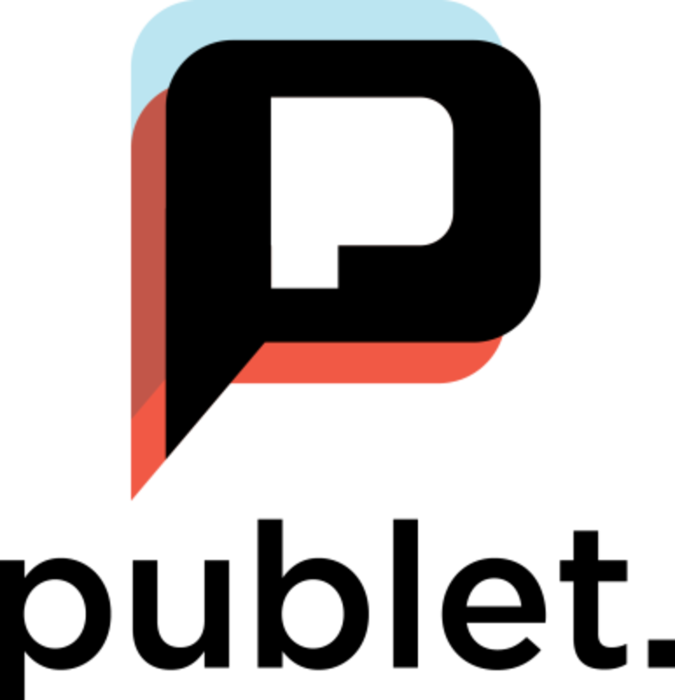Link
http://publet.com
Specifications
Publet is a digital publishing platform for creating multimedia content.
Features include tools to create responsive HTML5 publications (with no coding or training experience necessary) that can include images, video, audio, and custom interactive elements. Clients can use existing templates or create custom templates that include brand logos, assets, fonts, and colors.
All publications are optimized for mobile devices and desktop computers and can viewed on unique URLs, saved as PDFs, or sent to e-readers. Clients have the ability to set up registration, subscription, and paywall features.
The platform integrates with social media channels and with Marketo, Salesforce, Eloqua and other CRMs. Analytics include various real-time reader engagement metrics (clicks, watches, reads, and shares), A/B testing, and more.
Cost
Monthly cost ranges from $50 for two users and five publications to $1,200 for 10 users and 20 publications. Enterprise and agency pricing for 50+ users and 250+ publications is available upon request. A free beta version is available for one user and one publication.
User
Sunmin Kim, deputy editor at The Economist Intelligence Unit, has been using Publet since December 2014.
How do you use it?
Publet set up the backend for us and built in custom brand specifications.
So far, we’ve only used Publet for a project with one deliverable – an ebook based on a research paper that we created for NetApp. I gave Publet a PDF of the research paper, and they uploaded the color schemes and graphics into their backend system. Then I could log on to the platform and make editing and formatting changes.
The platform has a very rich text editor that allows you to see changes in real-time and how the content will look on the Web.
The editing functions are structured in what I would consider modules. There are different modules for different elements. You can drop in text, hyperlinks, connections to social media channels, or multimedia elements. You can also click and drag within a page to move elements.
I needed to get Publet’s engineering team involved in a couple of elements. For example, they built a custom element for us so I could use video clips that play on repeat in the headers. They also built our branding into the headers and footers.
We set up the backend to sync with our internal data capture tools and with Google Analytics.
I’ve been working very closely with Publet representatives, and I can email or call anytime I need help. The platform has been stable. The only issues I’ve had have been related to customization.
How does it serve your business needs?
I work on the thought leadership editorial team, which is within the content solutions unit of The Economist Intelligence Unit. We create sponsored research products such as surveys, briefing papers, white papers, videos, infographics, and more.
Business audiences are starting to demand richer digital formats, and we were looking for a vendor that knew how to translate PDF content into a format for a digital-first business audience.
I had three specific objectives for the NetApp ebook. I needed a responsive Web design that would work equally well on mobile and desktop devices. The content also needed to be interactive and more visually rich than a PDF briefing paper. Publet allowed me to meet all of these objectives.
In content marketing, it’s increasingly important to capture more fine-tuned data. We built a gate into the NetApp ebook that allows us to capture leads, and because it lives on the Web we get all the same data and analytics we would get out of any webpage.
How does it integrate with your existing infrastructure from an IT standpoint?
The platform for creating and editing content is online. Our marketing team worked with Publet’s team to sync the platform with our internal data capture tools and with Google Analytics.
What are the main benefits?
Translating PDF content into responsive Web design content is seamless. And the ability of Publet’s team to build in custom features is great.
The team understands online reader behavior and how to capture data around it. They also know how push content to readers.
What are the main drawbacks?
The NetApp ebook was a challenging and fast-moving project. We needed to add features at the last minute, and the turnaround time to add new features extended our schedule a bit.
What would you like to see improved/added?
I would love annotation tools for readers. For example, it would be great if readers could highlight something and the link could capture it so colleagues with whom they share the link could see what was highlighted.
We do a lot of survey research. As we move toward putting data visualizations on the Web, I’d love it if Publet can make them more interactive.
Competitors
DocSend: provides tools for tracking, optimizing, and controlling access to business documents.
Issuu: digitial publishing and reading platform.
Populr: provides tools to create, share, and track webpages
Squarespace: a content management system that includes a website builder.








